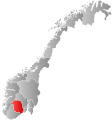Fyresdal
| Fyresdal kommune | |||
|---|---|---|---|
| Municipality | |||
|
|||
 Fyresdal within Telemark |
|||
| Coordinates: 59°9′57″N 8°1′11″E / 59.16583°N 8.01972°ECoordinates: 59°9′57″N 8°1′11″E / 59.16583°N 8.01972°E | |||
| Country | Norway | ||
| County | Telemark | ||
| District | Vest-Telemark | ||
| Administrative centre | Moland | ||
| Government | |||
| • Mayor (2015) | Erik Skjervagen (Ap) | ||
| Area | |||
| • Total | 1,281 km2 (495 sq mi) | ||
| • Land | 1,108 km2 (428 sq mi) | ||
| Area rank | 71 in Norway | ||
| Population (2004) | |||
| • Total | 1,347 | ||
| • Rank | 383 in Norway | ||
| • Density | 1/km2 (3/sq mi) | ||
| • Change (10 years) | -2.0 % | ||
| Demonym(s) | Fyresdøl | ||
| Time zone | CET (UTC+1) | ||
| • Summer (DST) | CEST (UTC+2) | ||
| ISO 3166 code | NO-0831 | ||
| Official language form | Nynorsk | ||
| Website | www |
||
|
|
|||
Fyresdal is a municipality in Telemark county, Norway. It is part of the traditional region of Vest-Telemark. The administrative centre of the municipality is the village of Moland. The municipality of Moland was established on 1 January 1838 (see formannskapsdistrikt). In 1879, the name was changed to Fyresdal.
The Old Norse form of the name was Fyrisdalr. The first element is the genitive case of the name of the lake Fyrir (now called Fyresvatn). The last element is dalr which means "valley" or "dale". The name of the lake is derived from the word fura which means "pine tree". Prior to 1879, the municipality was called Moland.
The coat-of-arms is from modern times. They were granted in 1992. The arms show two silver-colored broadaxes on a green background. It was chosen to represent the forestry work in the municipality.
Fyresdal is known for its many findings from the Viking Age, its mighty Viking graves, heaps of slag, and the former pilgrim church that once stood proudly north of the village centre. People travelled to this church from all over Norway and even from Europe. It was said that the stream running behind the church had healing powers.
A few miles south of the site where the Heggland Pilgrim Church (Norwegian: Heggland Kyrkje), once stood at Molandsmoen, a stone with Runic inscriptions can be found. This is a reminder from the Viking Age when horse battles were held there. Originally, one believes, there were four of them. Klokkarhamaren is a little mountain on a peninsula in the municipal centre, and it is the location of a cave called Munkhola. It is believed that a certain number of monks in Medieval times resided, held masses, and sought refuge here.
...
Wikipedia


